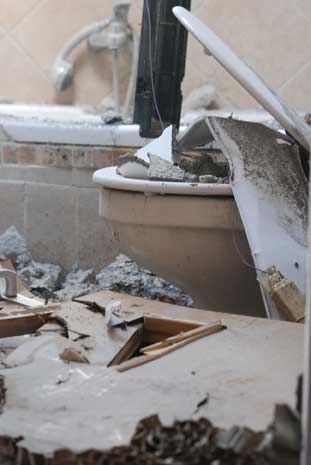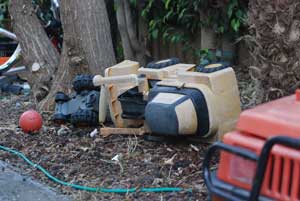Local bat mitzvah girl celebrates by helping protect one house from Qassam rockets.
Last month, a few days before Yom Ha’atzmaut, my family and I went to Sderot. The trip was the idea of my 12-year-old daughter, Kira. Ever since we moved to Vancouver from
Israel in the summer of 2006, she has had it in her mind that Sderot was the place for which she wanted to do a chessed (act of kindness) project for her bat mitzvah this year.
Photo: Hamutal Ben Shitrit
Kira’s aim was to fix up a public bomb shelter with a portion of the proceeds from her bat mitzvah, to make it more comfortable for children who might need it for refuge from the daily barrage of rockets from Gaza. However, the public shelter idea turned out to have a few logistical problems, so she switched to Plan B: a safe room for a single family.
As we got closer to our departure for Israel, she asked if it was dangerous in Sderot. I explained to her about the constant rain of rockets on the city, that we might need to run to a shelter ourselves and that I would completely understand if she decided not to go through with the visit. She told me she would like a night to sleep on it before rendering her decision. The next morning, she woke up and said, “Mummy, we should go. Hashem will watch over us.”
So we went. We celebrated her bat mitzvah in Jerusalem. We visited Sderot. And Hashem did indeed watch over us. We were already home by the time a Qassam landed on the roof of a supermarket not far from where we’d had coffee and not far from the home of the Malka family, with whom we’d connected via the Sderot Media Centre (SMC) and had visited a few hours earlier.
Carmit and Oshri Malka are the parents of Noam, 6, and Idan, 4. A few days before our visit, as the last drops of water were still draining from Noam’s and Idan’s morning bath, a Qassam smashed through the roof of their home, leaving the newly renovated bathroom in a shambles, the small, neat house damaged and filled with debris, and the security of the family’s world shattered forever. Only the goldfish still swimming freely in their tank, which remarkably survived intact, bore witness to the assault.
photo: Hamutal Ben Shitrit
“I can’t bring the boys here to see this. It’s too frightening,” said Carmit Malka. Noam, she added, even before this happened, refuses to go to the bathroom without her because he’s afraid he’ll be caught literally with his pants down and unable to get to a shelter in time.
According to the SMC, more than 4,000 bombs have landed on the western Negev since Israel withdrew from Gaza in August 2005; more than 8,000 since the rocket attacks began in 2001. Eleven civilians have died and more than 500 have been injured. Every day, multiple rockets from Gaza are launched across the desert, targeted at the 250,000 Jewish civilians who live in Sderot, Netivot Ashkelon and 20 moshavim and kibbutzim in the region – civilians who live inside time-honored, internationally recognized borders of the state of Israel. Upwards of 750 families in Sderot do not have a bomb shelter or safe room.
Today, neither do the Malkas. Their bathroom doubled as their safe room. Now it lies in ruins. Rebuilding their home will be both emotionally and financially taxing for the family. The government is already stonewalling them in their efforts to apply for reimbursement for even a small portion of the damage to their home. The couple has resignedly joined the ranks of many others who have preceded them down this same road and hired a lawyer to sue the state. It will be a lengthy and costly process, with no guarantee of a successful outcome.
“We are not part of the country. The government doesn’t care about us. We are alone here,” said Oshri Malka. “Carmit said to me that we should load the Qassam that fell on our house on a truck and dump it on a street in Tel Aviv and start screaming, ‘Look a Qassam has fallen here! Now what are you going to do?'” he recounted.
Sderot is a very surreal place. Even as terror rains from the sky, life continues on the ground. If you didn’t know you were in a bomb zone, you wouldn’t be able to tell from the pace and (near) normalcy of everyday life in the area. It is flowering and beautiful, like most towns in Israel. It is filled with people walking the streets and shopping in the supermarkets, customers idling over a coffee in the local café and the laughter of children echoing from the schoolyards.
But looks are deceiving. Life here is not like other places. When you enter Sderot, the first thing you do is unbuckle your seat belt. It’s explained that the rule to “buckle up” doesn’t apply in these parts. With only 15 seconds from rocket launch and the tzeva adom (red alert) siren to rocket explosion, the precious seconds you save by not having to unbuckle your belt may be the difference between making it to the safety of the nearest bomb shelter or dying in your car, which was the fate of one unfortunate soul.
It is not until you take a second look around that you notice the things which mark this place as different: a hard metal shell covering that school over there, making it look like a giant mechanical turtle about to spring to life; iron bars and steel on the end of that high school building, marking it as the “safe” section during an attack; the sunny yellow bus shelters built of re-enforced concrete that provide street-side havens for when the tzeva adom sounds and bomb shelters large; and small punctuating the blocks of businesses and residences.
What you don’t see readily upon the landscape are the other signs of trauma to the town: the reduction in revenue of local businesses as citizens relocated to safer centres, taking their shopping dollars with them; the schools who have no students because they, too, have moved away; and the PTSD (post-traumatic stress disorder), which, according to a recent study by Natal, the Israel Trauma Centre for Victims of Terror and War, afflicts up to 94 per cent of children ages seven to 12, and 28 per cent of adults in Sderot.
“I see it every day,” explained Carmit Malka, a preschool teacher by profession. “The children, including even my own boys with their friends, play tzeva adom games. One child shouts, ‘Tzeva adom, tzeva adom,’ and the rest run and hide. They take turns playing dead.”
In spite of everything, the Malkas’ only goal now is to go home. They have no plans to relocate permanently to Ashkelon, where they have been staying in a hotel. The couple’s roots, their families and their dreams of giving their children the same childhoods they enjoyed are all still in Sderot. Besides, Noam hid all the “For Sale” signs his mother made in a moment of despair and told her, “Mummy, don’t bother looking for them, I hid them too well.”
The Malkas had been on the verge of applying for a bank loan to cover the cost of repairs when they received my note telling them about our family’s bat mitzvah donation. They literally received our news the day they’d decided to bite the mortgage bullet option. The note she wrote me was a tear jerker: “The Talmud says if you save one life, it is as if you’ve saved the world.”
Kira’s (and our) goal was to commit ourselves to saving one family. According to Carmit Malka, we saved theirs. Literally. It’s nice to think someone views our family as angels from God but I’m not sure “saving” a family from the hassles and financial burdens of a bank loan are exactly what the Talmud meant.
At the very least, with our help, as well as the contributions made by friends in honor of Kira, the Malkas can begin rebuilding their home immediately, reclaim their lives and fortify a secure place for their family, so that the next time a Qassam sails from Gaza to Sderot, Oshri, Carmit, Noam and Idan will be safe.
Hodie Khan lives in Vancouver.











